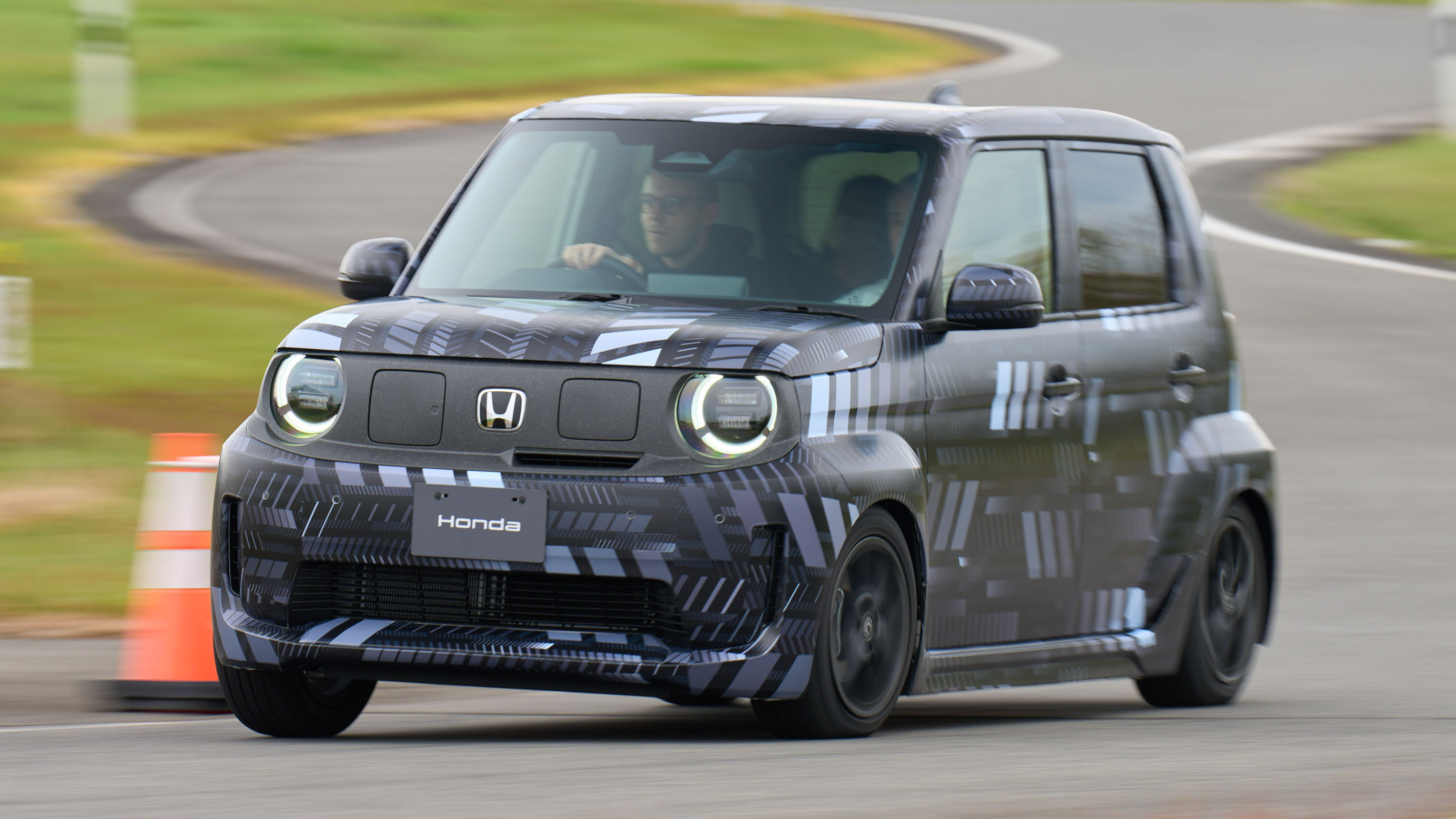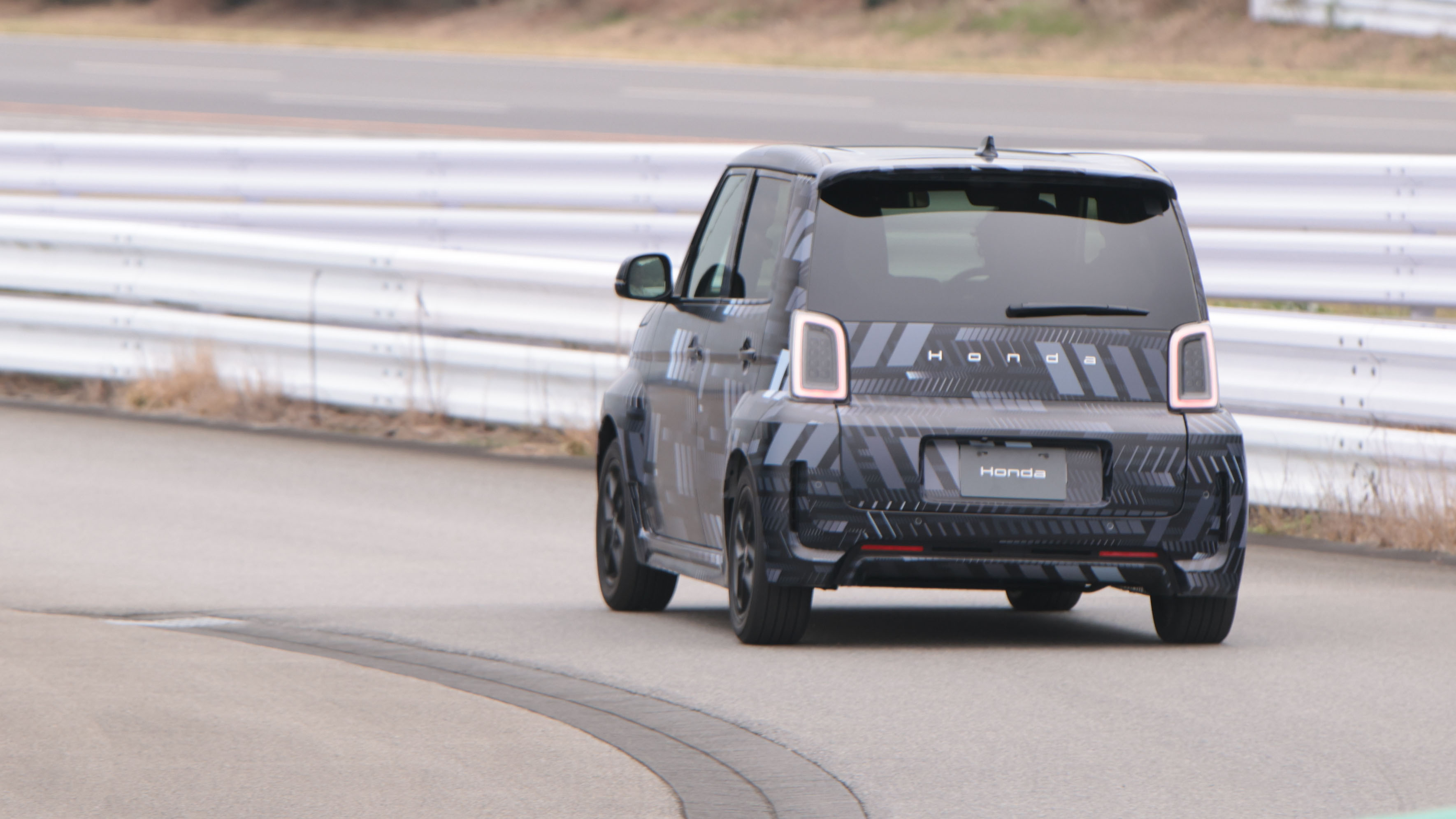
Honda Super-N prototype review: will this micro hot hatch take Japanese kei-cars mainstream?
Awwh! I mean, ‘grrrr’.
A particular sort of cuteness beams from the Honda Super-N – because it’s trying so adorably hard to be aggressive, with its flexed wheelarch muscles and doe-eyed grumpy expression. It wants to be king of the jungle like a Civic Type R, but it’s completely harmless. They should’ve called it Simba.
Why’s it called the Super-N?
In Japan Honda offers a family of kei cars called the N Series. Not to be confused with fast Hyundais. In 2024, EVs were added to the line-up. The first was a hilariously earnest people carrier riding on the wheels from a suitcase called the N-Van e.
The other is a five-door hatchback with the height-to-width ratio of a telephone box called the N-One e. The Super-N is basically the powered-up, slightly widened, hot version of the N-One e.
In Japan and Asia, this car’s going to be badged ‘Super-One’. Brits will have to call it Super-N because Honda wanted to distance the name from the Mini One, and there’s already a long-standing go-kart championship called Super One. Definitely should’ve called it Simba. Or Scrappy-Doo.
Remind me what a kei-car is again?
A piece of brilliant Japanese thinking that deserves to go global. Short for ‘kei-jidōsha’ or ‘light vehicle’, kei cars were a timely Japanese innovation to help the country get mobile and rebuild industry after the Second World War.
They are deliberately small, urban-friendly runabouts – even the most recent rules revamp in 1998 said a kei car could be no more than 3.4 metres long, 1.48 metres wide and less than two metres tall. And you can’t produce more than 63bhp.
Did the idea catch on?
Massively. At times since the 1960s more than a third of annual Japanese car sales have been teeny kei heroes.
If you had to pick one car to sum up a nation’s car industry, America’s would be an enormous double-cab V8 pick-up truck. Germany’s would be a business express autobahn saloon, Italy’s a flamboyant supercar. And Japan’s would be the brilliantly packaged, considerately dimensioned kei car. Genius – and this one will be in British Honda dealerships in July 2026.
At last! A small, light, cheap electric car. What are the numbers?
Erm. Ooh. Dunno. Sorry.
We’ve had a very brief turn in a nearly-there Super-N prototype at Honda’s Gran Turismo-legendary Tochigi test track. The team behind it radiate pride at what they’ve built… but aren’t yet prepared to reveal a complete list of specs.
Top Gear
Newsletter
Thank you for subscribing to our newsletter. Look out for your regular round-up of news, reviews and offers in your inbox.
Get all the latest news, reviews and exclusives, direct to your inbox.
Here’s what we can suss out. It’s front-wheel drive, with single-motor propulsion. Discs brakes up front, drums on the rear. Usually it produces just 63bhp, but in BOOST Mode (more on that shortly) power climbs by what feels like a double-digit amount.
The standard N One e carries a low-slung 29kWh battery good for a 150-180-mile range. Let’s presume that’s not changed, because changing that is expensive.
We expect the Super-N will weigh in a smidge heavier than the 1,300kg N-One e because of its wider track, beefier suspension and chunkier body extensions, but not a lot.
First impressions?
The door couldn’t be any lighter (or thinner) if it was made of rice paper. You stoop into a sit-up-and-beg driving position on a narrow but chunkily bolstered seat. There are no alloy drilled pedals, lashings of Alcantara or carbon, but the iridescent purple ‘BOOST’ button on the steering wheel spoke is promising. Paddleshifters are plastic, unlike the crisp metal paddles in the new Prelude coupe.
As you’d expect from the looks, elbow room is narrow, headroom is vast and it’s not expensively appointed, but it is easy to get along with. A physical button panel handles air-con and heated seats. You get the same touchscreen as a Civic. The steering wheel’s a good thickness but the generously bolstered seats are a bit of a pinch for a Westerner.
Still, it’s bizarre to sit in a modern car that feels so impossibly narrow. And because you can spot the corners of the stumpy bonnet, the Super-N immediately gives you that urban car confidence only possible when you know exactly where the edges are, how much space you need and where to exploit it. And yet it’ll seat a six-foot passenger behind a six-foot driver in more comfort than a Honda e did. It’s brilliantly packaged.
How does it drive?
Press the POWER button and the screens wake up with little fanfare. Prod ‘D’ for Drive and the Super-N sidles away. It’s not fast, but it steers with precision and feels refreshingly microscopic. Narrow especially, but never liable to topple over, because you sense the heaviest bit (the battery) is safely anchored beneath your feet. It’s a perfectly biddable town car, but not especially interesting beyond the novelty of its size.
Is this where BOOST Mode enters the chat?
It is. Prod the purple button and sportier gauges appear in the digital display. A synthetic engine burble erupts from the speakers. And the throttle pedal chins some Red Bull. We’re not yet sure how much extra power this unlocks.
Why can it develop more than the kei limit of 63bhp? Because the Super-N isn’t strictly a kei-car – those blistered wheelarches are too wide for the rules. So it can technically sidestep the power curfew…
Either way, it’s now brisk. Still not fast, and never likely to trouble the teeny 15in tyres for traction, but zippier. Though, that sense of speed is tripled because the speakers are now imagining it’s a four-pot hot hatch with a six-speed gearbox, so you’ve got a familiar crescendo and interruptions to the soundtrack.
It’s obviously fake – no-one would reasonably believe it’s an authentic petrol car. But the canned backing track adds a dimension to the experience.
And what if I start flapping the paddles?
Hold down the left paddle for two seconds and you get a ‘manual’ mode and can take control of the imagined gearbox yourself. And Honda’s had some fun here, because you can run into the redline, and engage some subtle ‘engine braking’ via re-gen calibrated to feel like a downshift.
It’s much, much more restrained than the Hyundai Ioniq 5 N and 6N’s fully committed hot hatch cosplay. Honda’s engineers admit the base N-One e’s package limits what they can do with the Super-N, though gimmicks like pops’n’bangs or alternative downloadable soundtracks could be possible in future.
It’s a clever trick, because although the ‘shifts’ are seamless, it immediately makes you more engaged with the drive.
Is this the future of making EVs fun to drive?
Well, AMG and Porsche have admitted they’re working on augmented shift systems with noise trickery, so Hyundai’s influence looks to be assured. We’d love Honda’s effort here to be more overt, but it’s on the right track.
Heck, if we’re gamifying driving let’s lean into it. Let’s have sports and race exhaust modes to simulate fruity soundtracks. Let’s offer challenges and rewards for nailing six perfect upshifts, or the loss of a hot streak score if you ask for a downchange too early.
Embarrassingly, the Super-Ns bound for the UK will have a louder engine noise inside, because Honda’s engineers discovered the pre-programmed volume was drowned out by the din caused by the UK’s awful road surfaces. Remember that when your local MP next claims ‘other countries have it just as bad as we do.’
How’s the handling?
The Super-N is safe. It resists power understeer, but we were only able to drive with traction control and ESP on. It’ll tighten its cornering line with a lift off the throttle, but it’s nothing like as over-engineered to oversteer as something like the much-missed Fiesta ST. It reminded me of the RWD Renault Twingo GT: a tall car on narrow tyres, so Honda has to be responsible in the set-up to avoid topsy-turvy waywardness.
Brakes are sensitive at the top of the pedal, but you’re never carrying so much speed that they feel necessary. They’re more of a nice-to-have reassurance.
So what’s the (prototype) verdict?
The Super-N’s clearly not a die-hard performance car. It’s a city runabout that’s been injected with a thimbleful of humour. But it looks sweet, it’s fun enough to drive and should be practical enough to justify to the head once it’s won over your heart. What matters now is the pricing.
What’ll it cost?
A Dacia Spring starts around £15k. A Renault 5 begins at £24k. That’s a nice chunky EV-toddler gap for the Super-N to slide into. Honda has a potential hit on its hands here, and can’t afford to fluff the landing like the Honda e did: similarly cute, but big on price and short on range.
Still, there are grants to be had, and EU lawmakers say they want Europe to invoke a new era of cheap, simple ‘E cars’ to safeguard the future of the car industry. Or… just import some kei cars. The Japanese have been right about these things for decades. Time for the rest of the world to catch on.
Featured

Trending this week
- Long Term Review
How efficient is the hybrid Dacia Bigster?






